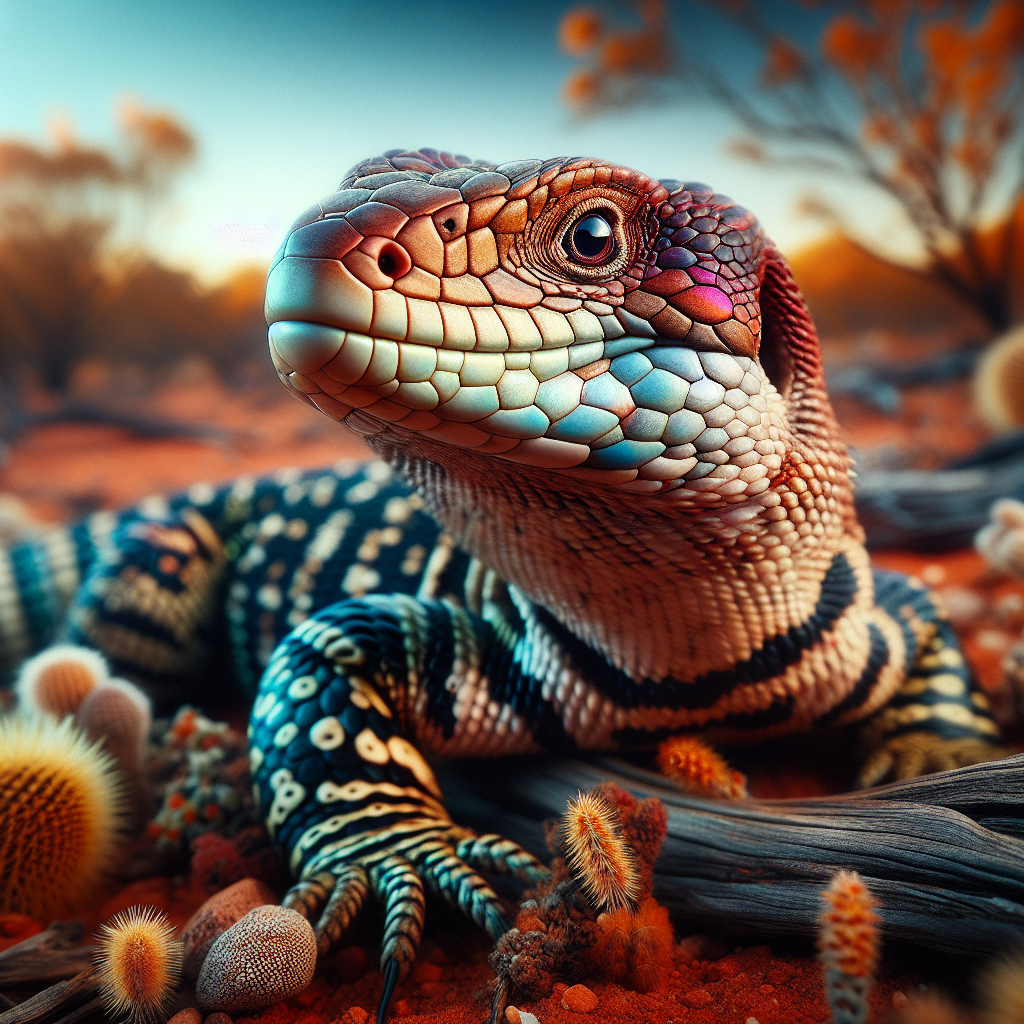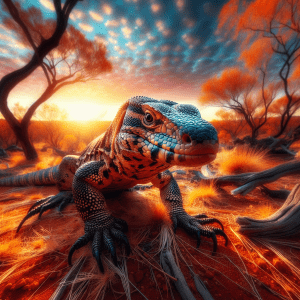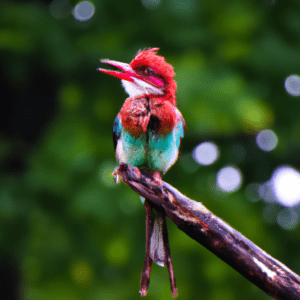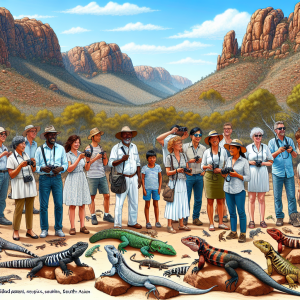Introduction: Exploring the Lizard Diversity of the Australian Outback
Have you ever marveled at the incredible diversity of lizards that call the vast Australian Outback home? It’s truly a sight to behold! As one of the foremost experts on lizard species in this region, I am delighted to share my passion for these fascinating creatures with you.
Let me take you on a journey through the sun-scorched landscapes and rocky terrains where lizards reign supreme. The Australian Outback is a haven for a wide array of lizard species, each uniquely adapted to survive in this harsh environment. From the iconic Thorny Devil to the elusive Shingleback, every lizard has its own story to tell.
One interesting fact about lizard diversity in the Australian Outback is the remarkable variety of colors and patterns that these reptiles exhibit. From vibrant blues and greens to earthy browns and yellows, the camouflage techniques used by these lizards are simply astounding. It’s like a living mosaic of nature unfolding before your eyes!
Now, imagine yourself trekking through the red sands of the Outback, keeping a keen eye out for a glimpse of these elusive creatures. Spotting a well-camouflaged lizard basking on a rock or scurrying across the desert floor is a thrill like no other. It’s a true testament to the resilience and adaptability of these remarkable animals.
As we delve deeper into the world of Australian Outback lizards, we’ll uncover the challenges they face in the modern world. Habitat loss, climate change, and human interference pose significant threats to the delicate balance of this ecosystem. Understanding these challenges is crucial to ensuring the long-term survival of these unique species.
So, as we embark on this journey together, I invite you to open your mind to the wonders of lizard diversity in the Australian Outback. Let’s celebrate the beauty and complexity of these ancient reptiles and work together to protect their natural habitats for generations to come.
Importance of Lizards in the Ecosystem
Lizards, the unsung heroes of the Australian Outback ecosystem, play a crucial role in maintaining balance and biodiversity. These fascinating creatures are not just scaly and mysterious; they are essential in keeping insect populations in check and serving as prey for larger predators.
Let me share with you an interesting fact about the importance of lizards in the ecosystem. Did you know that some lizard species are known to consume hundreds of insects in a single day? That’s right! Lizards are voracious eaters of pests like mosquitoes and ants, helping to control their populations naturally without the need for harmful chemicals.
Imagine a world without lizards roaming the Outback – insect populations would skyrocket, disrupting the delicate balance of the ecosystem. This is why conserving lizard diversity is crucial for maintaining a healthy and thriving environment.
One practical tip to appreciate the significance of lizards in the Outback is to observe their interactions with other species. Notice how lizards provide food for birds of prey and how their presence influences the behaviors of nearby animals. By understanding these intricate relationships, we can truly grasp the interconnectedness of all living beings in the ecosystem.
So, the next time you spot a lizard basking in the sun or darting across the red desert sands, take a moment to appreciate the vital role they play in the Australian Outback. From their unique adaptations to their diverse behaviors, lizards are truly remarkable creatures worth celebrating and protecting.
Unique Species of Lizards in the Australian Outback
Have you ever marveled at the incredible diversity of lizard species that call the Australian Outback home? Let’s dive into the fascinating world of these unique reptiles and explore the remarkable adaptations that have allowed them to thrive in this harsh environment.
Australian Outback is home to a wide variety of lizard species, each with its own distinct characteristics and behaviors. From the iconic Thorny Devil to the elusive Shingleback, these lizards have evolved over time to survive in the arid landscapes of the Outback. One interesting fact about these lizards is their ability to regulate their body temperature by basking in the sun or seeking shade, depending on the conditions.
One of the most intriguing aspects of studying lizard diversity in the Australian Outback is uncovering the different adaptations that have enabled these creatures to thrive in such extreme conditions. For instance, the Frilled Lizard is known for its unique defensive display where it expands a frill around its neck to appear larger and intimidate potential predators.
As we delve deeper into the world of Australian Outback lizards, it’s important to consider the conservation efforts aimed at protecting these incredible creatures. Habitat loss, climate change, and invasive species pose significant challenges to the survival of many lizard species in the Outback. By raising awareness and promoting conservation initiatives, we can help safeguard the future of these remarkable reptiles.
So, next time you find yourself exploring the vast expanses of the Australian Outback, keep an eye out for the diverse array of lizards that inhabit this unique ecosystem. Their resilience, adaptability, and beauty serve as a testament to the wonders of nature and the importance of preserving biodiversity for future generations to enjoy.
Adaptations of Lizards to the Outback Environment
Have you ever marveled at how lizards manage to thrive in the harsh and unforgiving environment of the Australian Outback? It’s truly a testament to their remarkable adaptations and resilience. Let’s dive into the fascinating world of how these incredible creatures have evolved to conquer the challenges of their arid home.
One of the most intriguing aspects of Australian Outback lizards is their unique adaptations to the extreme conditions of their environment. Picture this – a desert landscape stretching as far as the eye can see, scorching temperatures during the day, and bone-chilling cold at night. How do these cold-blooded creatures not only survive but thrive in such a harsh setting?
Well, Australian Outback lizards have developed some extraordinary strategies to beat the heat and conserve water. For instance, did you know that some species of lizards in the Outback have specialized skin that allows them to blend seamlessly into their surroundings, providing both camouflage and protection from predators? Others have evolved the ability to regulate their body temperature by basking in the sun during the day and seeking shelter in cool crevices when it gets too hot.
Imagine encountering a Thorny Devil, with its spiky armor-like skin and unique ability to trap and channel water towards its mouth using capillary action. It’s like a real-life superhero, equipped with its own survival toolkit!
As we delve deeper into the world of Australian Outback lizards, we begin to appreciate the intricate balance of nature and the interconnectedness of all living things. These remarkable creatures not only play a crucial role in the ecosystem but also serve as a reminder of the resilience and adaptability of life in the face of adversity.
So, the next time you find yourself in the vast expanse of the Australian Outback, take a moment to observe these incredible lizards in their natural habitat. Their survival strategies and unique characteristics are sure to leave you in awe of the wonders of the natural world.
Conservation Efforts for Australian Outback Lizards
When it comes to photographing lizards in their natural habitat in the Australian Outback, one thing is for sure – patience is key. Picture this: you’ve set up your camera, ready to capture a stunning shot of a vibrant agama lizard basking in the sun. You wait, holding your breath, as the lizard slowly inches closer to your lens. Suddenly, it scurries away, leaving you with a blurred image of its tail. Frustrating, right?
To avoid missing those perfect moments, here’s a handy tip: blend in with your surroundings. Lizards are incredibly perceptive to movement and unfamiliar objects, so the more you can camouflage yourself, the better your chances of capturing them in their natural state. Consider wearing earthy tones and moving slowly to avoid startling these elusive creatures.
Another fascinating aspect of photographing lizards in the Australian Outback is observing their unique behaviors. Did you know that some lizards perform elaborate mating dances to attract a mate? It’s like a miniature ballet performance right before your eyes! These intricate displays of courtship are not only beautiful to witness but also provide valuable insights into the complex social dynamics of these reptilian creatures.
As you venture into the vast expanse of the Outback in search of these mesmerizing lizards, remember to tread lightly and respect their natural habitat. These resilient creatures have evolved over millions of years to thrive in this harsh environment, and it’s our responsibility to ensure their continued survival.
So, next time you embark on a lizard photography expedition in the Australian Outback, channel your inner stealth mode, embrace the waiting game, and get ready to capture the enchanting world of lizards in all its glory. Who knows, you might just snap the shot of a lifetime that tells a story worth a thousand words.
Best Places to Spot Lizards in the Outback
When it comes to spotting lizards in the vast expanse of the Australian Outback, it’s all about being in the right place at the right time. Picture this: the sun is high in the sky, casting a warm glow over the rugged terrain as you scan the landscape for any sign of movement. Suddenly, you catch a glimpse of a slender figure darting across the red dirt – a lizard!
These elusive creatures have evolved remarkable camouflage techniques to blend in with their surroundings, making them a thrilling challenge to spot. As you observe them in their natural habitat, you’ll be amazed by the diversity of species that call the Outback home. From the iconic Thorny Devil with its spikey exterior to the swift and agile Sand Goanna, each lizard has its own unique characteristics that make them a wonder to behold.
But here’s the kicker – did you know that some lizards in the Australian Outback have the ability to change color based on their mood or the temperature around them? Imagine witnessing this magical transformation firsthand, a true testament to the fascinating adaptations of these remarkable creatures.
As you embark on your lizard-spotting adventure, remember to tread lightly and respect their environment. Lizards play a crucial role in the ecosystem, controlling insect populations and serving as prey for larger predators. By observing them from a distance and refraining from disturbing their natural behaviors, you can help ensure their continued presence in the Outback for generations to come.
So, the next time you find yourself in the Australian Outback, keep your eyes peeled for these elusive reptiles. Who knows what wonders you might discover in the hidden world of lizard diversity?
Tips for Photographing Lizards in their Natural Habitat
In the captivating world of Australian Outback lizards, observing their behavior in their natural habitat is truly a remarkable experience. Picture this: you’re quietly crouched behind a bush, camera in hand, waiting for the perfect moment to capture a lizard in action. As you watch, you begin to notice the intricate and fascinating behaviors these reptiles exhibit.
Australian Outback lizards are known for their unique behaviors, from intricate mating rituals to impressive displays of territorial dominance. Did you know that some lizard species perform elaborate courtship dances to attract a mate? It’s like watching a carefully choreographed performance unfold right before your eyes.
As you observe these behaviors, you may start to wonder about the reasons behind them. Why do lizards engage in such elaborate displays? What purpose do these behaviors serve in their survival in the harsh Outback environment? Understanding the intricacies of lizard behavior can provide valuable insights into their adaptation to this challenging ecosystem.
For aspiring wildlife photographers, capturing these behaviors on camera can be a thrilling challenge. Finding the right angle, adjusting the lighting, and waiting for the perfect moment to click the shutter – it all adds to the excitement of documenting these remarkable creatures in their natural element.
So, the next time you find yourself in the Australian Outback, keep an eye out for the subtle movements and behaviors of the lizards around you. You never know what fascinating displays you might witness and capture through your lens. After all, each moment spent observing these incredible creatures brings us closer to appreciating the rich biodiversity of the Australian Outback.
Fascinating Behaviors of Australian Outback Lizards
Now, let’s dive into the fascinating behaviors of Australian Outback lizards. Did you know that some species of lizards perform elaborate mating dances to attract a mate? It’s truly a sight to behold in the wild! These intricate displays often involve colorful body movements and vocalizations, showcasing the agility and beauty of these reptiles.
Observing these mating rituals can provide valuable insights into the social dynamics and reproductive strategies of Australian Outback lizards. As a researcher who has spent countless hours studying these behaviors, I’ve been captivated by the intricacies and nuances of their courtship displays. Each species has its unique way of communicating and expressing interest, making it a delightful experience to witness in person.
One particular memory that stands out is the time I witnessed a pair of frilled lizards engaging in a mesmerizing dance under the scorching Outback sun. Their vibrant frills expanded like colorful sails, creating a breathtaking spectacle against the arid landscape. It was a reminder of the beauty and resilience of these creatures in their natural habitat.
Understanding these behaviors not only adds to our knowledge of lizards but also highlights the importance of preserving their habitats. As we delve deeper into the world of Australian Outback lizards, we uncover a rich tapestry of behaviors that contribute to the overall biodiversity of this unique ecosystem.
So, the next time you venture into the Australian Outback, keep an eye out for these mesmerizing displays of nature’s creativity. You never know what fascinating behaviors you might witness and how they can deepen your appreciation for the diverse and wondrous world of lizards in the Outback.
Threats to Lizard Diversity in the Outback
As we delve into the topic of threats to lizard diversity in the Australian Outback, it’s crucial to understand the impact of human activities on these fascinating creatures. From habitat destruction to climate change, lizards face various challenges that put their survival at risk.
Imagine this – you’re hiking through the rugged terrain of the Outback, marveling at the diverse lizard species around you. Suddenly, you come across a sign of human encroachment, a stark reminder of the threats these creatures face. This personal anecdote underscores the delicate balance between human development and wildlife conservation in the Outback.
The reality is that human activities such as urbanization, agriculture, and mining have led to habitat loss and fragmentation, making it difficult for lizards to find suitable living spaces. As a result, many species are pushed to the brink of extinction, disrupting the natural biodiversity of the region.
One interesting fact to consider is that some lizard species in the Outback have evolved unique adaptations to survive in harsh conditions. However, these adaptations may not always be enough to combat the rapid changes brought about by human interference and climate change.
So, what can we do to protect the rich lizard diversity of the Australian Outback? One practical tip is to support conservation efforts and raise awareness about the importance of preserving these iconic reptiles. By advocating for sustainable land management practices and minimizing our ecological footprint, we can help safeguard the future of these remarkable creatures.
The broader significance of addressing threats to lizard diversity extends beyond just protecting individual species. It’s about preserving the intricate web of life in the Outback and maintaining the overall health of the ecosystem for generations to come. By taking action today, we can ensure that these ancient reptiles continue to thrive in their natural habitat.
Conclusion: Preserving the Rich Lizard Diversity of the Australian Outback
Have you ever marveled at the incredible diversity of lizards that call the Australian Outback their home? From the vibrant colors of the Thorny Devil to the lightning-fast movements of the Perentie, these fascinating creatures never cease to amaze me.
Let me share an interesting fact with you – did you know that the Australian Outback is home to over 600 species of lizards, making it a hotspot for reptile enthusiasts and researchers alike? Each species has its own unique adaptations that help them thrive in the harsh desert environment.
As one of the leading experts on lizard diversity in the Outback, I’ve had the privilege of studying these remarkable creatures up close. One of my most memorable experiences was encountering a Frilled Lizard during a research expedition. Its iconic frill, which it expands to intimidate predators, was a sight to behold!
Now, let’s delve into a practical tip for those of you who are planning to explore the Outback in search of lizards. Remember to wear sturdy hiking boots and bring plenty of water – the Outback can be unforgiving, and being prepared is key to a successful lizard-spotting adventure.
Have you ever wondered about the significance of preserving the rich lizard diversity of the Australian Outback? These reptiles play a crucial role in the ecosystem, controlling insect populations and serving as prey for other predators. By protecting their habitats, we are not only safeguarding these unique species but also maintaining the balance of the entire ecosystem.
So, whether you’re a seasoned herpetologist or simply a nature enthusiast, I invite you to join me in celebrating the beauty and importance of lizard diversity in the Australian Outback. Who knows what fascinating encounters await you in this vast and captivating landscape?




